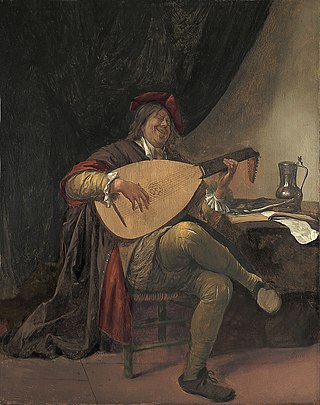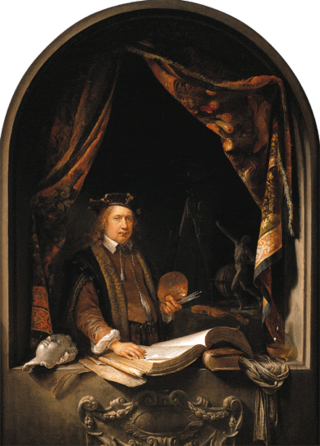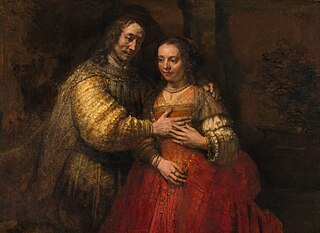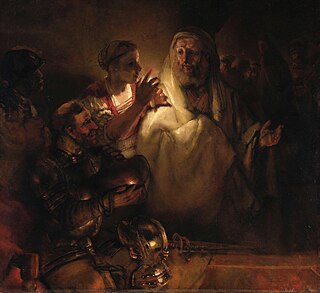
The Rijksmuseum is the national museum of the Netherlands dedicated to Dutch arts and history and is located in Amsterdam. The museum is located at the Museum Square in the borough of Amsterdam South, close to the Van Gogh Museum, the Stedelijk Museum Amsterdam, and the Concertgebouw.

Jan Havickszoon Steen was a Dutch Golden Age painter, one of the leading genre painters of the 17th century. His works are known for their psychological insight, sense of humour and abundance of colour.

GovertTeuniszoon Flinck was a Dutch painter of the Dutch Golden Age.

Militia Company of District II under the Command of Captain Frans Banninck Cocq, also known as The Shooting Company of Frans Banning Cocq and Willem van Ruytenburch, but commonly referred to as The Night Watch, is a 1642 painting by Rembrandt van Rijn. It is in the collection of the Amsterdam Museum but is prominently displayed in the Rijksmuseum as the best-known painting in its collection. The Night Watch is one of the most famous Dutch Golden Age paintings.

Gerrit Dou, also known as GerardDouw or Dow, was a Dutch Golden Age painter, whose small, highly polished paintings are typical of the Leiden fijnschilders. He specialised in genre scenes and is noted for his trompe-l'œil "niche" paintings and candlelit night-scenes with strong chiaroscuro. He was a student of Rembrandt.

Nicolaes Maes was a Dutch painter known for his genre scenes, portraits, religious compositions and the occasional still life. A pupil of Rembrandt in Amsterdam, he returned to work in his native city of Dordrecht for 20 years. In the latter part of his career he returned to Amsterdam where he became the leading portrait painter of his time. Maes contributed to the development of genre painting in the Netherlands and was the most prominent portrait painter working in Amsterdam in the final three decades of the 17th century.

Frans van Mieris the Elder, was a Dutch Golden Age genre and portrait painter. The leading member of a Leiden family of painters, his sons Jan (1660–1690) and Willem (1662–1747) and his grandson Frans van Mieris the Younger (1689–1763) were also accomplished genre painters.

Ferdinand Bol was a Dutch painter, etcher and draftsman. Although his surviving work is rare, it displays Rembrandt's influence; like his master, Bol favored historical subjects, portraits, numerous self-portraits, and single figures in exotic finery.

Rembrandt Harmenszoon van Rijn, usually simply known as Rembrandt, was a Dutch Golden Age painter, printmaker and draughtsman. An innovative and prolific master in three media, he is generally considered one of the greatest visual artists in the history of art and the most important in Dutch art history. It is estimated Rembrandt produced a total of about three hundred paintings, three hundred etchings and two thousand drawings.

Aert de Gelder was a Dutch painter. He was the only Dutch artist to paint in the tradition of Rembrandt's late style into the 18th century.

The Jewish Bride is a painting by Rembrandt, painted around 1665‒1669.
Events from the year 1660 in art.

Titus van Rijn was the fourth and only surviving child of Rembrandt Harmenszoon van Rijn and Saskia van Uylenburgh. Titus is best known as a figure or model in his father's paintings and studies but also because of a legal case as preferential heir.

Hendrickje Stoffels was the longtime partner of Rembrandt. The couple were unable to marry because of the financial settlement linked to the will of Rembrandt's deceased wife Saskia, but they remained together until Hendrickje's death. In 1654 she gave birth to Rembrandt's daughter Cornelia. In the later years of their relationship Hendrickje managed Rembrandt's business affairs together with the painter's son Titus.

Jan Abrahamsz Beerstraaten or Johannes was a Dutch painter of marine art, particularly of events of the First Anglo-Dutch War and Dutch-Swedish War. Van Beerstraten depicted ports (Civitavecchia) and cityscapes of Amsterdam, as well as many cities and villages in the Netherlands. He captured castles, churches and other buildings that no longer exist.

The dozens of self-portraits by Rembrandt were an important part of his oeuvre. Rembrandt created approaching one hundred self-portraits including over forty paintings, thirty-one etchings and about seven drawings; some remain uncertain as to the identity of either the subject or the artist, or the definition of a portrait.

The Denial of Peter is a 1660 painting by Rembrandt, now in the Rijksmuseum in Amsterdam. It depicts the denial of Peter, an event in the Passion of Jesus.

The Serenade is a 1629 oil painting by Judith Leyster in the collection of the Rijksmuseum. It was attributed for centuries to Frans Hals until Wilhelm von Bode saw it in the Six collection in 1883. He noticed the prominent "J" in the signature, and attributed it to Jan Hals. This is one of seven paintings first properly attributed to Leyster by Hofstede de Groot ten years later in 1893.

Portrait of Catharina Hooghsaet (1607–1685) is a 1657 painting by the Dutch Golden Age painter Rembrandt.

Pallas Athene is a c. 1655 oil-on-canvas painting by Rembrandt, now in the Calouste Gulbenkian Museum in Lisbon.



















